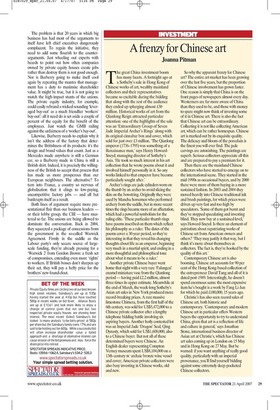A frenzy for Chinese art
Joanna Pitman
The great China investment boom has many facets. A fortnight ago at a Sotheby’s sale in Hong Kong of Chinese works of art, wealthy mainland collectors and their representatives became so excitable during the bidding that along with the rest of the audience they ended up splurging almost £30 million. Historical works of art from the Qianlong Reign attracted particular attention: one of the highlights of the sale was an ‘Extraordinary Group of Seven Jade Imperial Archer’s Rings’ along with its original cinnabar box and cover, which sold for just over £3 million. ‘The Qianlong emperor (1736–1795) was something of a Renaissance man,’ says Henry HowardSneyd, managing director of Sotheby’s Asia. ‘He took so much interest in his art collection that he wrote poems about it and involved himself personally in it. So any works linked to that emperor have become particularly sought after.’ Archer’s rings are jade cylinders worn on the thumb by an archer to avoid slicing the skin on the bowstring. Originally they were used by Manchu horsemen who performed archery from the saddle, but in more recent times the rings became more of an affectation, which had a powerful symbolism for the ruling elite. ‘These particular thumb rings have poems inscribed on them which reflect his philosophy as a ruler. The dates of the poems cover a 30-year period, so they’re interesting in that they reveal his changing thoughts about life as an emperor, beginning very much in a martial spirit, and ending in a more thoughtful and philosophical tone about what it means to be a ruler.’ Another private Chinese buyer went home that night with a very rare ‘Falangcai’ enamel miniature vase from the Qianlong period — having paid £2.2 million, almost three times its upper estimate. Meanwhile at the end of March, the week-long Sotheby’s Asian art sales in New York produced more record-breaking prices. A rare massive limestone Chimera, from the first half of the 6th century, was sold for US$5,472,000 to a Chinese private collector after a lengthy telephone bidding battle involving six aspiring buyers. Another hotly contested lot was an Imperial Jade ‘Dragon’ Seal, Qing Dynasty, which sold for US$1,608,000, also to a Chinese buyer. But not all of these determined buyers were Chinese. An English dealer representing Compton Verney museum spent US$8,104,000 on a 13th-century BC archaic bronze wine vessel and cover; American private collectors were also busy investing in Chinese works, old and new. So why the apparent frenzy for Chinese art? The entire art market has been growing over the last five years, but the proportion of Chinese involvement has grown faster. One reason is simply that China is on the front pages of newspapers almost every day. Westerners are far more aware of China than they used to be, and those with money to spare might now think of investing some of it in Chinese art. There is also the fact that Chinese art can be extraordinary. Collecting it is not like collecting American art, which can be rather homespun. Chinese art is marked out by its exquisite quality. The delicacy and bloom of the porcelain is the finest you will ever find. The jade carvings are astonishing. The paintings are superb. Serious collectors appreciate all this and are prepared to pay a premium for it.
Then there are the mainland Chinese collectors who have started to emerge on to the international scene. They started in the mid-1990s as occasional buyers, and by 2000 there were more of them buying in a more sustained fashion. In 2003 and 2004 they moved heavily into Chinese traditional ink and brush paintings, for which prices were driven up very fast and too high by speculators. ‘Some of them got burnt and they’ve stopped speculating and investing blind. They now buy at a sustained level,’ says Howard-Sneyd. Is there an element of patriotism about repatriating works of Chinese art from American owners and others? ‘They may justify it that way, but I think it’s more about themselves as collectors. The fact is, they’re hooked by the quality of this art.’ Contemporary Chinese art is also booming. Chinese art accounts for 90 per cent of the Hong Kong-based collection of the entrepreneur David Tang and all of it is dated post-1989. Interestingly, he doesn’t spend enormous sums: the most expensive item he’s bought is a work by Fang Li-Jun for which he paid £100,000, 15 years ago.
Christie’s has also seen record sales of Chinese art, both historic and contemporary. ‘Contemporary and modern Chinese art in particular offers Western buyers the opportunity to try to understand China, given that art is a reflection of life and culture in general,’ says Jonathan Stone, international business director of Asian art at Christie’s, which has Chinese art sales coming up in London on 15 May and in Hong Kong on 27 May. But be warned: if you want anything of really good quality, particularly with an imperial provenance, you’ll find yourself bidding against some extremely deep-pocketed Chinese collectors.


















































































 Previous page
Previous page